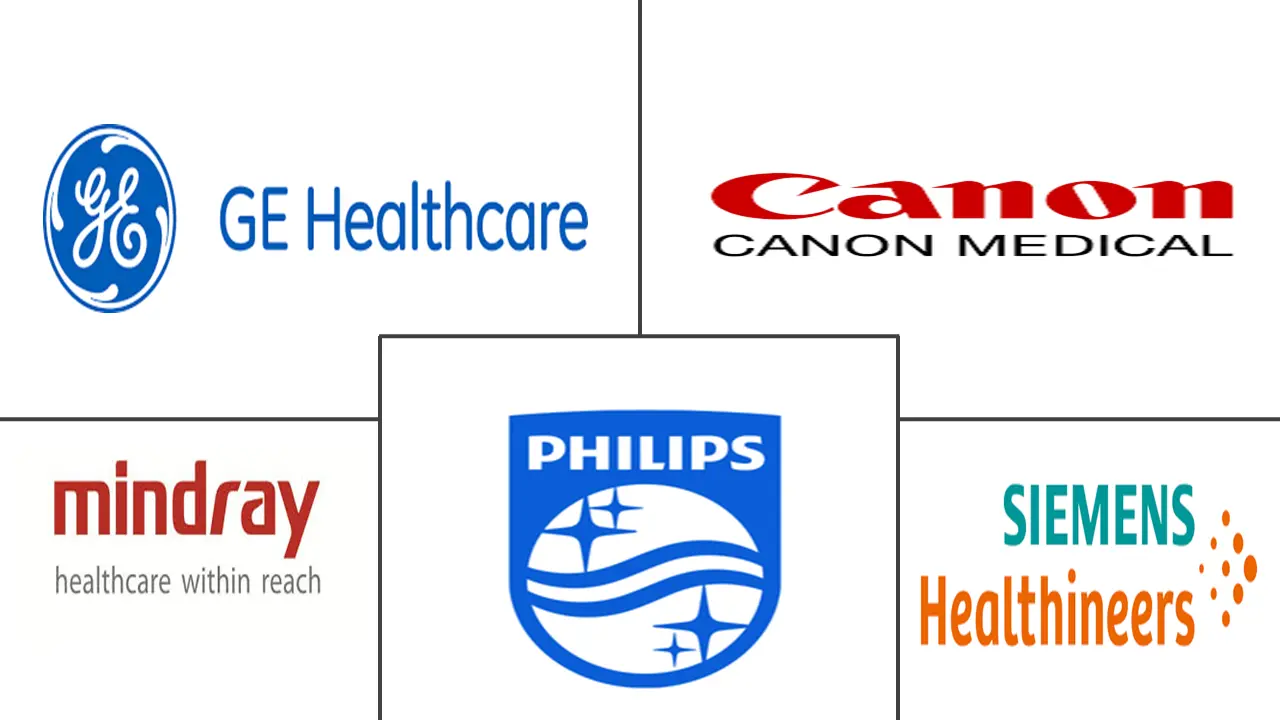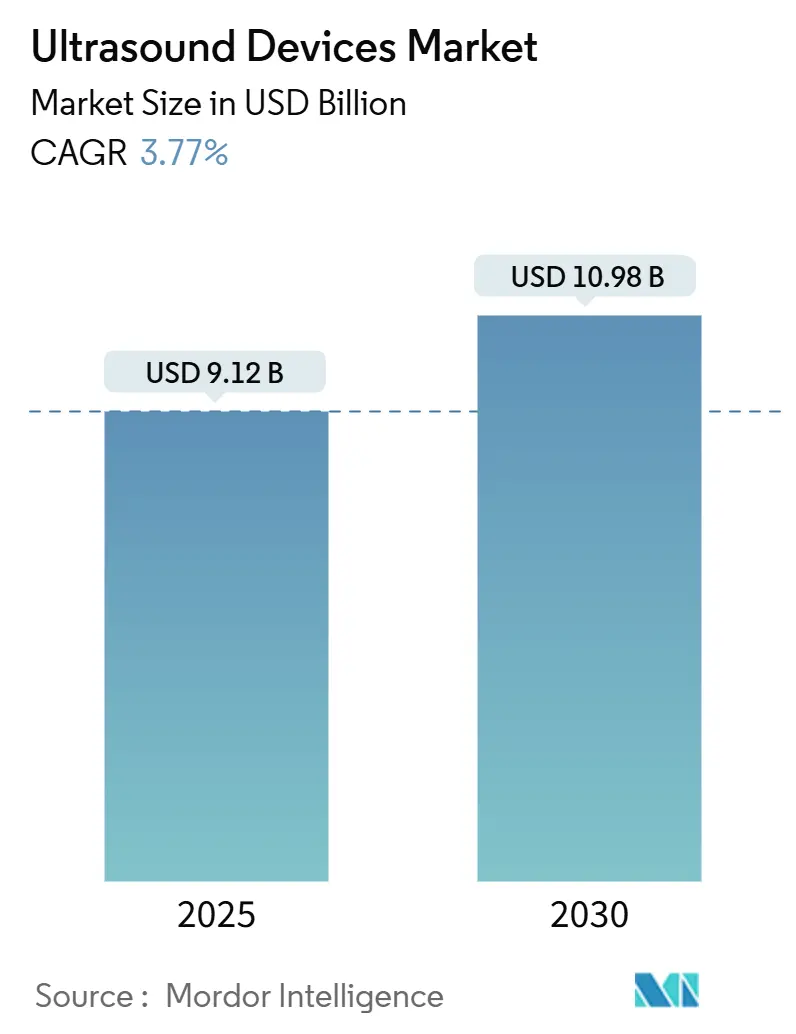
Ultrasound Devices Market Analysis by Mordor Intelligence
The Ultrasound Devices Market size is estimated at USD 9.12 billion in 2025, and is expected to reach USD 10.98 billion by 2030, at a CAGR of 3.77% during the forecast period (2025-2030).
Consistent demand for real-time, radiation-free imaging, rapid uptake of artificial intelligence (AI) in image acquisition and interpretation, and widening use of handheld probes in primary care underpin this growth. Clinical evidence shows AI guidance can lift the diagnostic quality of scans performed by non-experts to 98.3%, matching specialist performance. Mature markets keep driving replacement demand for premium 3D & 4D systems, while emerging economies propel first-time purchases through public health programs. A pivot toward minimally invasive procedures, combined with multimodal fusion platforms that overlay real-time ultrasound on CT or MRI, broadens the technology’s procedural role. At the same time, persistent reimbursement gaps for point-of-care devices in the United States and tightening global quality-system regulations temper momentum.
Key Report Takeaways
- By application, radiology accounted for a 23.3% share of the ultrasound devices market size in 2024, while anesthesiology is poised to accelerate at a 4.9% CAGR to 2030.
- By technology, 3D & 4D imaging held 45.6% of the ultrasound devices market share in 2024, whereas high-intensity focused ultrasound (HIFU) is forecast to post the fastest 5.1% CAGR to 2030.
- By portability, stationary consoles dominated with 69.6% revenue share in 2024; handheld units are set to record an 8.2% CAGR through 2030.
- By end user, hospitals commanded 55.1% of the ultrasound devices market size in 2024; home-care settings are projected to expand at a 10.5% CAGR.
- By region, North America led with 38.1% revenue in 2024; Asia-Pacific is the fastest-growing region at a 4.8% CAGR for 2025-2030.
Global Ultrasound Devices Market Trends and Insights
Drivers Impact Analysis
| Driver | (~) % Impact on CAGR Forecast | Geographic Relevance | Impact Timeline |
|---|---|---|---|
| Increasing incidences of chronic diseases | +1.3% | Global | Long term (≥ 4 years) |
| Growing minimally-invasive diagnostics and imaging facilities | +0.9% | Asia-Pacific, North America | Medium term (2-4 years) |
| Home-based pregnancy monitoring uptake | +0.6% | North America, Europe | Short term (≤ 2 years) |
| Expansion of tele-ultrasound networks | +0.5% | Emerging markets | Medium term (2-4 years) |
| Growing adoption of point-of-care ultrasound | +0.8% | Global | Short term (≤ 2 years) |
| AI-enhanced image reconstruction demand | +0.7% | North America, Europe | Medium term (2-4 years) |
| Source: Mordor Intelligence | |||
Increasing Incidences of Chronic Diseases
Cardiovascular, oncologic, and respiratory disorders account for most ultrasound referrals, making chronic-disease management a structural demand catalyst. An AI model for ovarian-tumor detection achieved an F1 score of 83.5%, surpassing expert radiologists. Similarly, deep-learning tools pinpoint the median nerve in carpal-tunnel scans with high accuracy. The American Cancer Society projects 2.04 million new cancer cases in the United States in 2025, up from 2.00 million in 2024, reinforcing long-term imaging demand. As AI accelerates workflow and elevates accuracy, it compensates for shortages of trained sonographers, broadening the user base and sustaining the ultrasound devices market.
Growing Minimally-Invasive Diagnostics and Imaging Facilities
A global pivot toward needle-guided biopsies, regional anesthesia, and musculoskeletal injections is deepening ultrasound’s procedural relevance. Fusion platforms that marry live ultrasound with CT, MRI, or PET scans are improving lesion targeting in complex cases. Facility growth reinforces the installed base: India counted 5,200 NABL-accredited labs in February 2024, 44% of which were radiology units.[1]National Accreditation Board for Testing and Calibration Laboratories, “Accredited Labs List,” nabl-india.org Australia listed 4,462 accredited imaging practices by December 2023, 81% clustered in three populous states.[2]Australian Commission on Safety and Quality in Healthcare, “Accredited Imaging Practices 2024,” safetyandquality.gov.au New centers such as ColumbiaDoctors/NY-Presbyterian’s Manhattan site opened in January 2025 to serve high-density urban catchments. This geographic spread of facilities feeds steady demand for both premium and mid-range ultrasound consoles, bolstering the ultrasound devices market.
Home-Based Pregnancy Monitoring Uptake
Handheld probes such as Vscan Air translate premium image quality into a cordless form factor, enabling prenatal scans outside hospitals. AI-embedded obstetric platformsexemplified by GE HealthCare’s Voluson series auto-measure fetal biometrics, shortening exam times while raising confidence. In underserved areas, early-risk detection via home scans triggers timely referrals and improves outcomes, a dynamic that broadens the ultrasound devices market beyond institutional boundaries.
Expansion of Tele-Ultrasound Networks
Cloud-connected software now streams live imaging feeds to specialists who guide novice operators in real time, reducing geographic barriers. Systems such as Philips Lumify with Reacts, Clarius Live and Butterfly iQ’s remote guidance gained traction during the COVID-19 public-health emergency. Research prototypes for robot-assisted ultrasound promise further reach once connectivity and reimbursement hurdles ease. These tele-consult platforms enlarge clinical reach without proportional capital outlays, reinforcing growth in the ultrasound devices market.
Restraints Impact Analysis
| Restraint | (~) % Impact on CAGR Forecast | Geographic Relevance | Impact Timeline |
|---|---|---|---|
| Limited reimbursement for hand-held scanners | -0.7% | United States | Short term (≤ 2 years) |
| Strict regulation for approval | -0.5% | Global | Medium term (2-4 years) |
| Portable device battery-life fatigue | -0.3% | Emerging markets | Medium term (2-4 years) |
| Acoustic attenuation in obese patient imaging | -0.2% | Global | Long term (≥ 4 years) |
| Source: Mordor Intelligence | |||
Limited Reimbursement for Hand-Held Scanners
Point-of-care ultrasound (POCUS) lacks dedicated billing codes for many primary-care indications. Fee-for-service models discourage broad deployment, constraining the ultrasound devices market in outpatient and home settings. Recent CMS proposals hint at progress, yet policy fragmentation across private payers persists, delaying return-on-investment for providers.
Strict Regulation for Approval
The U.S. FDA’s revised Quality-System Regulation, effective February 2026, harmonizes with ISO 13485 but raises short-term compliance costs. Concurrently, new pathways such as predetermined change-control plans streamline post-market tweaks. Device reclassification e.g., ultrasound cyclo destructive systems moving to class II reduces submission burdens. Outside the United States, India’s PCPNDT Act mandates strict center registration and record-keeping, circumscribing prenatal scan volumes. Collectively, these measures elongate time-to-market and elevate operating risk.
Segment Analysis
By Application: Radiology Sustains Scale as Anesthesiology Accelerates
Radiology applications generated 23.3% of the ultrasound devices market revenue in 2024, fueled by multi-organ imaging needs. AI modules that flag ovarian malignancies now surpass human expertise, pushing hospitals to upgrade radiology workstations. Elastography refinements have also sharpened liver-fibrosis staging, widening non-invasive screening libraries.
Procedure-guided anesthesiology is fleetingly smaller but expanding at a 4.9% CAGR. Nerve-block adoption benefits from color-overlay aids such as ScanNav Anatomy PNB, which simplifies landmark recognition for trainees. Hospitals keen to cut anesthetic drug volumes and postoperative pain are buying specialized linear probes, scaling the ultrasound devices market in perioperative suites.
Growing hospital budgets for point-of-care scanners, together with national-level guidance encouraging opioid-sparing analgesia, will likely sustain double-digit equipment refresh rates in anesthesia departments. As AI curates preset imaging protocols, clinicians gain confidence to extend ultrasound-guided blocks beyond orthopedics into emergency and intensive-care environments. This cross-departmental spillover lifts utilization rates, reducing per-scan costs and reinforcing the economic case for investing in advanced platforms within the broader ultrasound devices market.
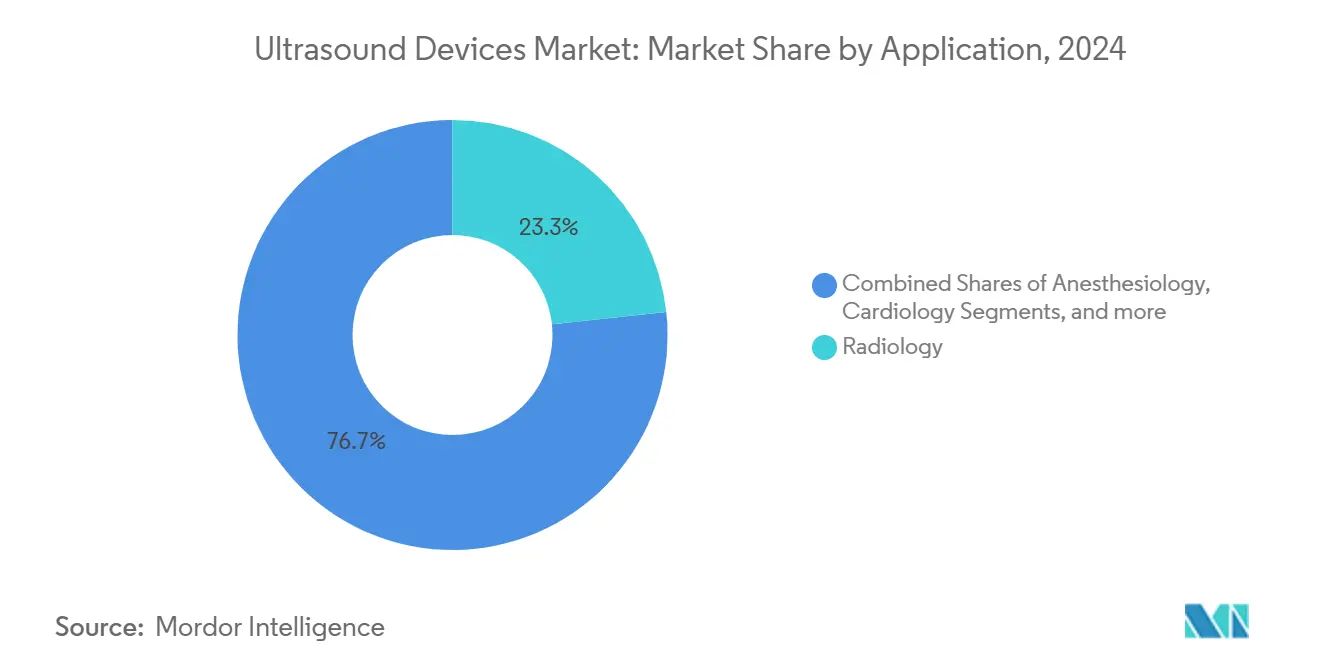
Note: Segment shares of all individual segments available upon report purchase
By Technology: 3D & 4D Imaging Holds Leadership, HIFU Builds Momentum
3D and 4D systems contributed 45.6% of the ultrasound devices market share in 2024. They are favored for obstetrics, pediatrics, and cardiology cases that need volumetric visualization. They are supported by machine-learning algorithms that auto-render fetal facial features in real time. Such automation frees clinicians to focus on counseling rather than knobology.
HIFU addresses niche but fast-scaling therapeutic areas from uterine fibroids to pancreatic tumors and is projected to grow at 5.1% CAGR. Academic trials indicate meaningful symptom relief with minimal recovery time, prompting payers in China and Europe to evaluate reimbursement frameworks. As surgical departments integrate HIFU into tumor boards, they diversify revenue streams while staying within radiology budgets, reinforcing the ultrasound devices market trajectory.
Integrated AI dashboards that quantify ablation zones instantaneously reduce intraoperative uncertainty. This precision complements oncology’s shift to outpatient day-care models, where rapid turnover and reduced infection risk are premiums. Consequently, technology vendors that meld high-frame-rate imaging with therapy beams will likely capture outsized share of incremental capital spending within the ultrasound devices market.
By Portability: Stationary Consoles Reign While Handheld Probes Surge
Hospital departments still favor cart-based consoles for their superior harmonics, dynamic-range depth, and integration with PACS; these units made up 69.6% of 2024 revenue. Yet purchasing committees are adding compact carts that dock tablets, bridging the stationary performance with mobility. A comparative study across six leading handheld devices crowned Vscan Air for usability and Lumify for superficial imaging. Such findings nudge clinicians to adopt portable probes for line placements and bedside lung assessments, expanding the ultrasound devices market.
Handhelds are forecast to compound at 8.2% annually, spurred by pricing that slips below USD 3,000 and subscription models bundling software updates. Wearable patches that capture continuous organ motion for 48 hours already show feasibility in cardiopulmonary monitoring.[3]NIH, “Stretchable Ultrasound Patches Provide Continuous Imaging,” nih.govOnce commercialization matures, these patches could redefine chronic-care protocols, representing the next disruption in the ultrasound devices market.
Manufacturers must balance ruggedness, battery longevity, and heat dissipation, especially in tropical climates. Cloud synchronization compliant with HIPAA and GDPR remains a design imperative as tele-ultrasound workflows proliferate. Firms that secure cybersecurity certifications will enjoy a trust premium, potentially tilting procurement decisions in favor of their offerings.
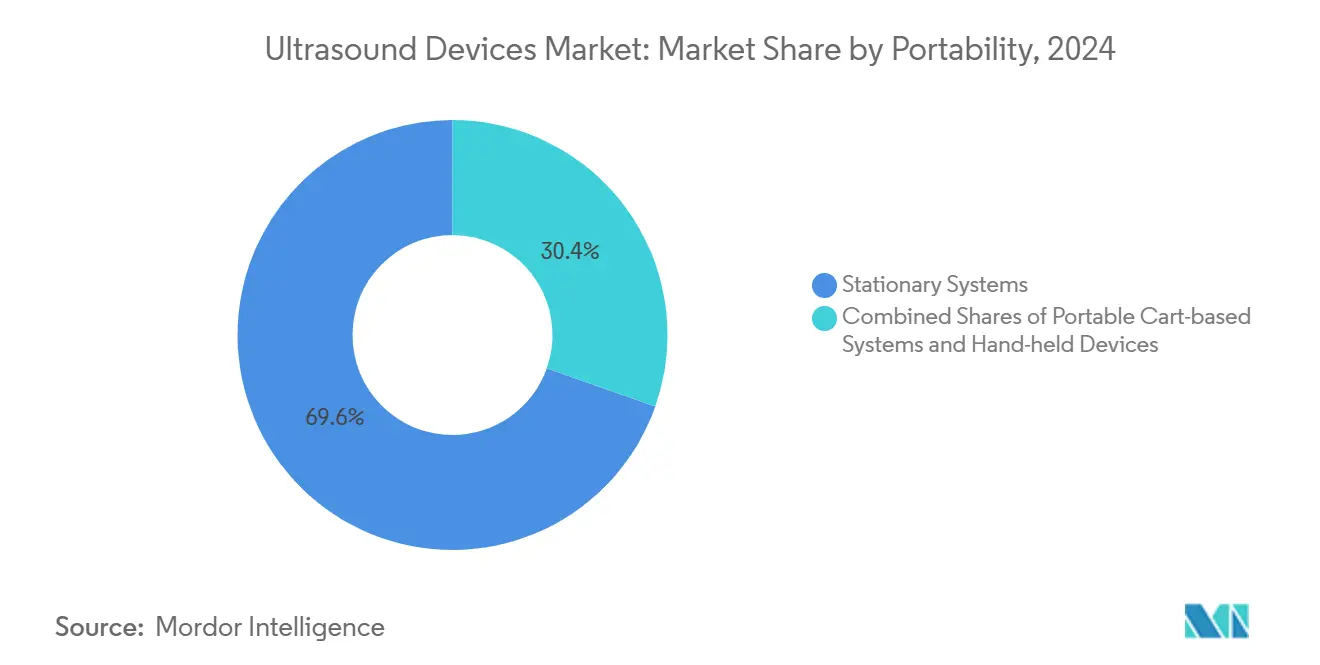
Note: Segment shares of all individual segments available upon report purchase
By End User: Hospitals Lead, Home-Care Expands Rapidly
Hospitals accounted for 55.1% of global spending in 2024, benefiting from multi-department utilization. The newest installations feature AI-powered preset optimization, as illustrated by Samsung Medison’s Z20 system for obstetrics. Hospitals also appreciate enterprise licensing that aligns ultrasound modalities with electronic medical records for seamless billing.
Home-care settings are projected to log the fastest 10.5% CAGR. Butterfly iQ3 combines a whole-body probe with automated measurements, aiding self-managed chronic-disease patients. Tele-ultrasound links connect nurses in community health centers to subspecialists, mitigating rural-care gaps. As reimbursement evolves from procedure-based to outcome-based models, payers acknowledge cost savings from early detection, further legitimizing at-home ultrasound pathways in the ultrasound devices market.
Digital-platform interoperability remains critical. Vendors offering software development kits for third-party integration with telehealth dashboards will likely capture disproportionate mindshare among home-health agencies. Education also matters: quick-start tutorials embedded in apps shorten learning curves, accelerating practitioner confidence and usage frequency.
Geography Analysis
North America retained a 38.1% revenue share in 2024 owing to strong payor coverage, a high chronic-disease burden, and steady technology refresh cycles. Launches such as Vave Health’s whole-body wireless device and GE HealthCare’s Automated Breast Ultrasound Premium illustrate the domestic appetite for AI-embedded innovation. Regulatory clarity and CPT codes for breast density screening underpin the quick onboarding of these solutions. Hospitals increasingly equip emergency departments with handheld probes, trimming triage times and improving bed flow, thus lifting the ultrasound devices market.
Asia-Pacific ranks as the fastest-growing region at a 4.8% CAGR. China dominates regional volume through procurement programs favoring domestically made consoles like Mindray’s Consona series. India’s “Make in India” ethos echoes through Wipro GE’s Versana Premier R3, an AI-ready system assembled in Bengaluru. Adoption of point-of-care ultrasound in overcrowded primary-care centers accelerates first-time purchases, though the PCPNDT Act restrains obstetric volumes. Nevertheless, public insurers increasingly reimburse liver and cardiac scans, sustaining the ultrasound devices market’s regional ascent.
Europe remains a technology-focused market. Agencies such as the European Medicines Agency require robust clinical data, prompting vendors to showcase evidence on dose-free imaging and interoperability with electronic health records. Focused-ultrasound milestones Insightec’s MRgFUS for essential tremor winning NUB status 1 reimbursement in Germany highlight innovation’s role in neurology and oncology insightec.com. WONCA Europe is rolling out structured ultrasound training for general practitioners, widening the community-care footprint. Collectively, these dynamics keep Europe a vital contributor to the ultrasound devices market.
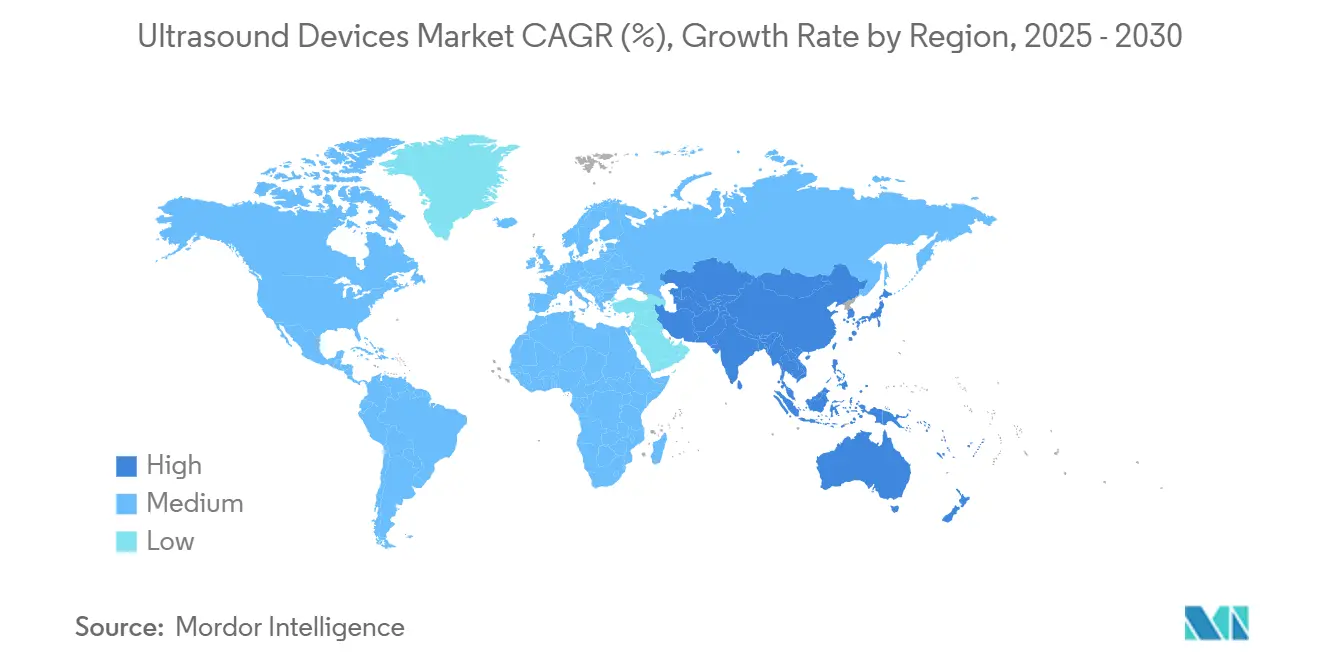
Competitive Landscape
The ultrasound devices market hosts a moderately concentrated cohort. The key players, such as GE HealthCare, Philips, and Siemens Healthineers, form the top tier, together accounting for a significant share of the global revenue. GE HealthCare advances segmentation with its SonoSAMTrack AI model that yields better accuracy, and Philips reinforces ecosystem stickiness through Reacts tele-consult software. At the same time, Siemens leverages Syngo Dynamics across modalities to lock in enterprise deals.
Mid-tier challengers Fujifilm, Canon Medical, and Mindray differentiate via cost-effective consoles for value segments and targeted acquisitions. Samsung Medison’s 2024 purchase of Sonio added explainable AI for obstetrics, positioning the brand to court women’s health chains. Fujifilm’s Arietta 850 launch in India marked an entry into the gastroenterology ultrasound niche.
Disruptors such as Butterfly Network enlarge the handheld category through semiconductor-based probes linked to subscription analytics. Butterfly booked 35% Q4 2024 revenue growth on the back of health-system deals and veterinary accounts. Clarius and Exo pursue similar chip-based strategies, promising margin benefits over piezoelectric transducers. As AI becomes table stakes, competitive advantage shifts to data curation, workflow integration, and payor advocacy within the ultrasound devices market.
Intellectual property portfolios are expanding: GE HealthCare filed over 200 AI-ultrasound patents in 2024, focusing on auto-detection algorithms. Regional players in China aggressively patent HIFU energy-control circuits, while European small caps chase niche applications in neuro-oncology. Cost pressure is spurring partnerships with semiconductor foundries to drive economies of scale in handheld categories. Mergers for data-science talent, rather than hardware, will likely characterize the next consolidation wave.
Ultrasound Devices Industry Leaders
GE Healthcare
Mindray Medical International Ltd
Koninklijke Philips NV
Siemens Healthineers
Canon Medical Systems Corporation
- *Disclaimer: Major Players sorted in no particular order
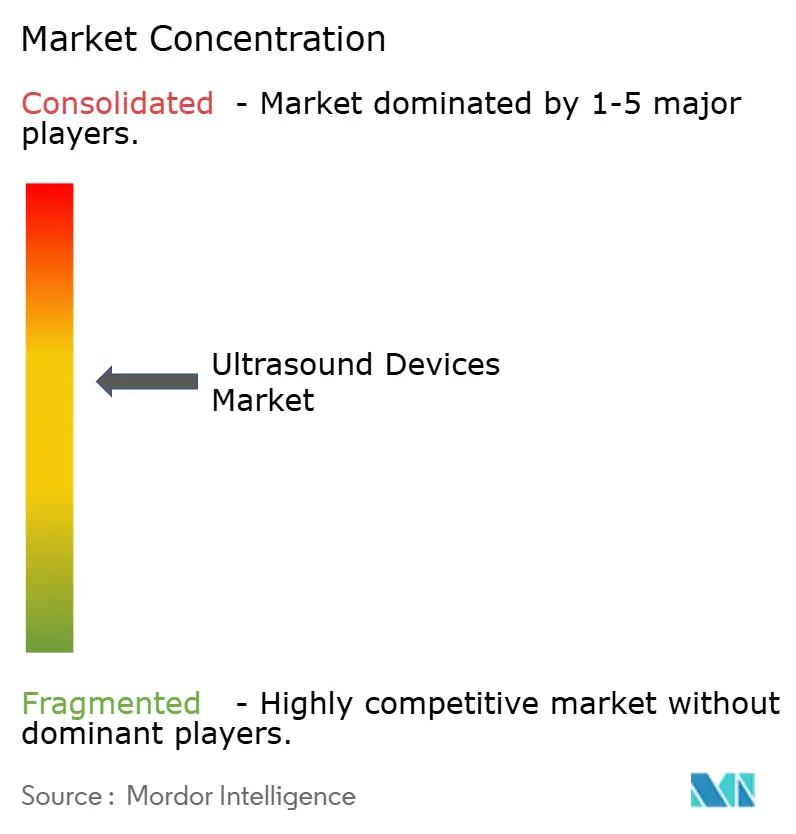
Recent Industry Developments
- March 2025: GE HealthCare deepened its collaboration with NVIDIA at the GPU Technology Conference (GTC) 2025, focusing on autonomous imaging technologies, including X-ray and ultrasound systems.
- January 2025: GE HealthCare's Voluson Expert Series ultrasound systems received 510(k) clearance from the FDA. These systems feature high-resolution imaging, advanced ultrasound technology, and AI-powered automation to enhance women’s healthcare diagnostics and workflow efficiency.
- June 2024: Siemens Healthineers Introduces Advanced Ultrasound Systems: In June 2024, Siemens Healthineers launched new ultrasound systems equipped with AI-powered features aimed at increasing diagnostic confidence and workflow efficiency in various clinical settings.
- May 2024: Samsung Medison acquired Sonio, an AI ultrasound company, to enhance its AI-driven diagnostic imaging portfolio and improve patient outcomes.
- January 2024: Philips partnered with Edith Cowan University in Australia to address staff shortages in the Asia-Pacific region. This initiative focuses on strengthening clinical ultrasound training to improve service delivery and expand patient care coverage.
Research Methodology Framework and Report Scope
Market Definitions and Key Coverage
Our study defines the global ultrasound devices market as the yearly sale value of brand-new diagnostic (2D, 3D & 4D, Doppler) and therapeutic (HIFU, ESWL) consoles, compact carts, and handheld systems that deliver medical images or focused acoustic therapy.
Scope exclusion: Refurbished scanners, stand-alone software, probes sold as spare parts, and post-warranty service contracts are excluded.
Segmentation Overview
- By Application
- Anesthesiology
- Cardiology
- Gynecology / Obstetrics
- Musculoskeletal
- Radiology
- Critical Care
- Urology
- Vascular
- Other Applications
- By Technology
- 2D Ultrasound Imaging
- 3D & 4D Ultrasound Imaging
- Doppler Imaging
- Contrast-Enhanced Ultrasound
- Elastography
- High-Intensity Focused Ultrasound
- By Portability
- Stationary Systems
- Portable Cart-based Systems
- Hand-held / Pocket Devices
- By End User
- Hospitals
- Diagnostic Imaging Centers
- Ambulatory Surgical Centers
- Maternity & Fertility Clinics
- Home-care Settings
- Veterinary Hospitals
- By Geography
- North America
- United States
- Canada
- Mexico
- Europe
- Germany
- United Kingdom
- France
- Italy
- Spain
- Rest of Europe
- Asia-Pacific
- China
- Japan
- India
- Australia
- South Korea
- Rest of Asia-Pacific
- Middle East & Africa
- GCC
- South Africa
- Rest of Middle East & Africa
- South America
- Brazil
- Argentina
- Rest of South America
- North America
Detailed Research Methodology and Data Validation
Primary Research
Structured interviews and short surveys with ultrasound product managers, hospital radiologists, biomedical engineers, and regional distributors across North America, Europe, Asia-Pacific, Latin America, and the Middle East help us validate utilization rates, average selling prices, and replacement cycles, while filling data gaps flagged during desk work.
Desk Research
We first map the market using reputable open data such as the WHO Global Health Expenditure Database, OECD Health Statistics, the US FDA 510(k) clearance archive, UN Comtrade shipments under HS 9018.12, and reports from bodies like the European Society of Radiology. Company 10-Ks, hospital procurement portals, medical-device patents via Questel, and news aggregations in Dow Jones Factiva enrich the competitive and pricing picture.
Our analysts then reconcile device unit flows with governmental capital-equipment surveys, trade association install-base tallies, and customs trends to set credible starting points. The sources listed are illustrative; many additional publications and databases are consulted for cross-checks and clarifications.
Market-Sizing & Forecasting
A top-down model converts procedure volumes and imaging-floor density into an addressable demand pool, which is then verified through selective bottom-up supplier revenue roll-ups and channel checks. Key variables, including live-birth and over-65 populations, hospital capital-spending trends, ultrasound exam mix, unit ASP erosion, and replacement cadence, feed a multivariate regression that produces the outlook for the forecast period. Where bottom-up estimates miss minor regions or specialty segments, we apply penetration coefficients derived from primary interviews to bridge gaps.
Data Validation & Update Cycle
Model outputs face anomaly scans, variance checks against independent metrics, and peer review before sign-off. Reports refresh each year, with interim revisions triggered by material events such as major regulatory changes or technology breakthroughs. A final analyst pass is completed just before client delivery.
Why Mordor's Ultrasound Devices Baseline Commands Reliability
Published estimates often diverge because firms adopt dissimilar scopes, currency bases, and refresh cadences. We acknowledge those differences upfront and clarify how each choice shifts the headline number.
Key gap drivers include whether therapeutic systems are counted, how handheld ASP decline is projected, and if refurbished sales are netted out.
Our disciplined scope selection, annual refresh, and dual-track modeling keep our baseline balanced and transparent.
Benchmark comparison
| Market Size | Anonymized source | Primary gap driver |
|---|---|---|
| USD 9.12 Bn (2025) | Mordor Intelligence | - |
| USD 10.19 Bn (2024) | Global Consultancy A | Includes refurbished and service revenue, single global ASP uplift |
| USD 9.32 Bn (2024) | Industry Publisher B | Excludes therapeutic systems, applies higher 6.8 % CAGR without currency realignment |
The comparison shows that once scope and currency assumptions are leveled, Mordor's figure sits between more aggressive and more conservative takes, giving decision-makers a reliable midpoint rooted in clearly traceable variables.
Key Questions Answered in the Report
What is the forecasted ultrasound devices market size by 2030?
The global ultrasound devices market size is expected to reach approximately USD 10.98 billion by 2030.
Which ultrasound technology segment is growing fastest?
High-Intensity Focused Ultrasound (HIFU) shows the highest growth momentum with a projected 5.1 % CAGR between 2025 and 2030.
How quickly are handheld ultrasound devices gaining market share?
Handheld and pocket-sized ultrasound devices are forecast to expand at about 8.2 % CAGR over 2025-2030, outpacing other portability segments.
Why is Asia-Pacific considered the most attractive growth region?
Expanding healthcare access, policy support for local manufacturing, and rising chronic disease incidence contribute to Asia-Pacific’s estimated 4.8 % CAGR through 2030.
How is artificial intelligence impacting ultrasound adoption?
AI improves diagnostic accuracy, reduces operator variability, and accelerates workflows, thereby broadening ultrasound use in both hospital and home-care settings.
